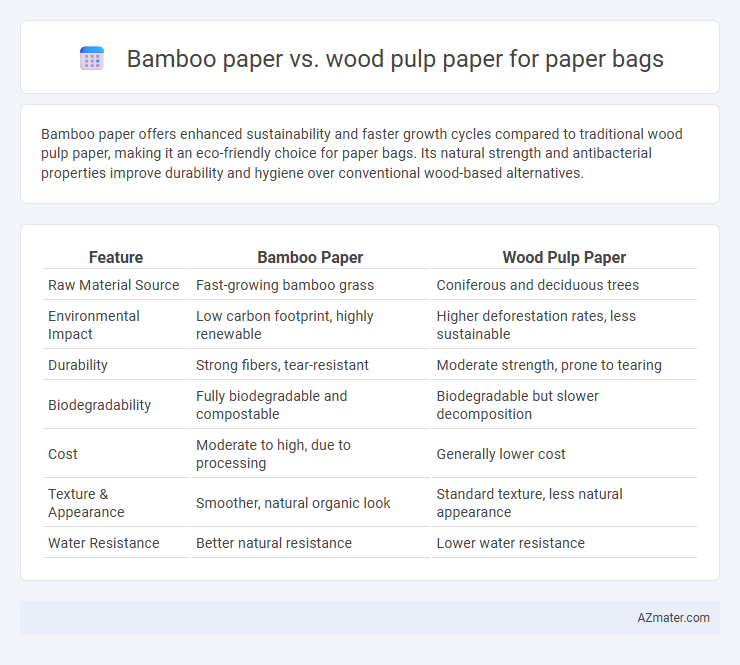Bamboo paper offers enhanced sustainability and faster growth cycles compared to traditional wood pulp paper, making it an eco-friendly choice for paper bags. Its natural strength and antibacterial properties improve durability and hygiene over conventional wood-based alternatives.
Table of Comparison
| Feature | Bamboo Paper | Wood Pulp Paper |
|---|---|---|
| Raw Material Source | Fast-growing bamboo grass | Coniferous and deciduous trees |
| Environmental Impact | Low carbon footprint, highly renewable | Higher deforestation rates, less sustainable |
| Durability | Strong fibers, tear-resistant | Moderate strength, prone to tearing |
| Biodegradability | Fully biodegradable and compostable | Biodegradable but slower decomposition |
| Cost | Moderate to high, due to processing | Generally lower cost |
| Texture & Appearance | Smoother, natural organic look | Standard texture, less natural appearance |
| Water Resistance | Better natural resistance | Lower water resistance |
Introduction: Bamboo Paper vs Wood Pulp Paper
Bamboo paper for paper bags offers exceptional sustainability with its rapid growth cycle and minimal pesticide use, making it an eco-friendly alternative to traditional wood pulp paper. Wood pulp paper, derived from slower-growing trees, involves more intensive resource consumption and longer regeneration periods. Bamboo's natural fibers provide enhanced strength and durability, optimizing paper bag performance compared to conventional wood-based counterparts.
Raw Material Sourcing and Sustainability
Bamboo paper for paper bags is derived from fast-growing bamboo plants, which can be harvested every 3-5 years, making it a highly renewable raw material compared to wood pulp paper sourced from slow-growing trees requiring decades to mature. Bamboo cultivation demands less water and no pesticides, contributing to lower environmental impact and enhanced sustainability, while wood pulp production often involves intensive logging and deforestation risks. The biodegradability and recyclability of bamboo paper further improve its eco-friendly profile, positioning it as a superior choice for sustainable paper bag manufacturing.
Environmental Impact Comparison
Bamboo paper for paper bags significantly reduces deforestation and carbon footprint compared to wood pulp paper, as bamboo grows rapidly and requires fewer pesticides and less water. Bamboo's natural antimicrobial properties and faster regeneration contribute to sustainable sourcing, minimizing soil erosion and habitat destruction commonly associated with traditional wood pulp harvesting. Lifecycle emissions of bamboo paper are lower, making it a more eco-friendly alternative for paper bag production in terms of resource efficiency and biodegradability.
Manufacturing Processes: Bamboo vs Wood Pulp
Bamboo paper for paper bags is produced using mechanical and chemical pulping processes that extract fibers from fast-growing bamboo stalks, resulting in a durable and sustainable material with minimal water and chemical use compared to wood pulp. Wood pulp paper manufacturing involves the extensive use of hardwood or softwood trees, requiring chemical treatments like kraft or sulfite pulping, which generate more waste and consume higher energy and water resources. Bamboo's rapid growth cycle and lower environmental impact in pulping make it a more eco-friendly alternative to traditional wood pulp in paper bag production.
Strength and Durability of Paper Bags
Bamboo paper for paper bags offers superior tensile strength due to the long, fibrous strands inherent in bamboo, making it highly resistant to tearing and wear compared to traditional wood pulp paper. Its dense fiber structure enhances durability, allowing bamboo paper bags to support heavier loads and withstand prolonged use without losing integrity. In contrast, wood pulp paper bags, while cost-effective, often have shorter fibers resulting in lower strength and quicker degradation under stress or moisture exposure.
Cost Analysis: Bamboo Paper vs Wood Pulp Paper
Bamboo paper for paper bags often incurs higher initial production costs due to the processing techniques required but benefits from faster raw material regeneration, potentially lowering long-term expenses. Wood pulp paper typically has lower upfront costs owing to established manufacturing infrastructure but faces price volatility linked to deforestation regulations and slower tree growth cycles. Evaluating total cost of ownership, bamboo paper may offer better economic sustainability despite higher per-unit costs compared to conventional wood pulp alternatives.
Print Quality and Aesthetic Appeal
Bamboo paper offers superior print quality for paper bags due to its smooth texture and uniform fiber composition, resulting in vividly sharp and consistent ink adherence. Wood pulp paper can exhibit more fiber irregularities that sometimes cause ink bleed or uneven printing, affecting the overall aesthetic appeal. The natural brightness and fine grain of bamboo paper enhance visual clarity and tactile feel, elevating the premium look of printed bags.
Biodegradability and Compostability
Bamboo paper for paper bags exhibits superior biodegradability and compostability due to its natural fibers that break down more quickly than wood pulp paper. Bamboo fibers decompose within a few months under composting conditions, releasing fewer harmful residues compared to the longer degradation period and potential chemical additives in wood pulp paper. Choosing bamboo paper enhances eco-friendly waste management by reducing landfill impact and supporting sustainable circular economies.
Consumer Perception and Market Trends
Consumers increasingly prefer bamboo paper over wood pulp paper for paper bags due to its eco-friendly attributes, faster renewability, and biodegradability, enhancing brand appeal in sustainability-conscious markets. Market trends show a rising demand for bamboo-based paper bags as regulations tighten against deforestation and single-use plastics, driving manufacturers to adopt alternative fiber sources. Bamboo paper's higher tensile strength and smooth texture also contribute to a positive consumer perception, positioning it as a premium and environmentally responsible choice in the paper bag industry.
Future Prospects for Sustainable Paper Bags
Bamboo paper offers a rapidly renewable, biodegradable alternative to traditional wood pulp paper, which heavily relies on deforestation and longer growth cycles. Its fast growth rate and high tensile strength make bamboo an ideal raw material for durable, eco-friendly paper bags that reduce carbon footprints. Future prospects include increased adoption of bamboo paper in the sustainable packaging industry due to its scalable cultivation and lower environmental impact compared to wood pulp-based paper.

Infographic: Bamboo paper vs Wood pulp paper for Paper bag
 azmater.com
azmater.com